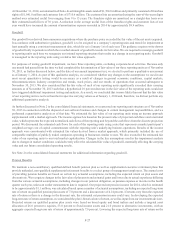Windstream 2014 Annual Report Download - page 142
Download and view the complete annual report
Please find page 142 of the 2014 Windstream annual report below. You can navigate through the pages in the report by either clicking on the pages listed below, or by using the keyword search tool below to find specific information within the annual report.
F-26
Critical Accounting Policies and Estimates
We prepare our consolidated financial statements in accordance with accounting principles generally accepted in the United States.
Our significant accounting policies are discussed in detail in Note 2 to the consolidated financial statements. Certain of these
accounting policies, as discussed below, require management to make estimates and assumptions about future events that could
materially affect the reported amounts of assets, liabilities, revenues and expenses and disclosure of contingent assets and liabilities.
We believe that the estimates, judgments and assumptions made when accounting for the items described below are reasonable,
based on information available at the time they are made. However, there can be no assurance that actual results will not differ
from those estimates.
Revenue Recognition
We recognize revenues and sales as services are rendered or as products are sold in accordance with authoritative guidance on
revenue recognition. We recognize certain revenues pursuant to various cost recovery programs from state and federal USF.
Revenues are calculated based on our investment in our network and other network operations and support costs. We have historically
collected the revenues recognized through this program; however, adjustments to estimated revenues in future periods are possible.
These adjustments could be necessitated by adverse regulatory developments with respect to these subsidies and revenue sharing
arrangements, the determination of recoverable costs, or decreases in the availability of funds in the programs due to increased
participation by other carriers.
See Note 2 to the consolidated financial statements for additional information regarding revenue recognition.
Allowance for Doubtful Accounts
In evaluating the collectability of our trade receivables, we assess a number of factors, including a specific customer’s ability to
meet its financial obligations to us, as well as general factors, such as the length of time the receivables are past due and historical
collection experience. Based on these assumptions, we record an allowance for doubtful accounts to reduce the related receivables
to the amount that we ultimately expect to collect from customers. If circumstances related to specific customers change or economic
conditions worsen such that our past collection experience is no longer relevant, our estimate of the recoverability of our trade
receivables could be further reduced from the levels provided for in the consolidated financial statements. A 10 percent change in
the amounts estimated to be uncollectible would result in a change in the provision for doubtful accounts of approximately $4.3
million for the year ended December 31, 2014.
Useful Lives of Assets
The calculation of depreciation and amortization expense is based on the estimated economic useful lives of the underlying property,
plant and equipment and finite-lived intangible assets. Our regulated operations use a group composite depreciation method. Under
this method, when plant is retired, the original cost, net of salvage value, is charged against accumulated depreciation and no
immediate gain or loss is recognized on the disposition of the plant. During 2012, with the assistance of outside expertise, we
completed analyses for certain subsidiaries of the depreciable lives of assets in service. Based on those results, we implemented
new depreciation rates resulting in a net increase to depreciation expense of $59.1 million and a net decrease in net income of
$36.5 million or $0.06 per share for the year ended December 31, 2012.
Rapid changes in technology or changes in market conditions could result in significant changes to the estimated useful lives of
our tangible or finite-lived intangible assets that could materially affect the carrying value of these assets and our future consolidated
operating results. An extension of the average useful life of our property, plant and equipment of one year would decrease
depreciation expense by approximately $109.2 million per year, while a reduction in the average useful life of one year would
increase depreciation expense by approximately $141.6 million per year.
























